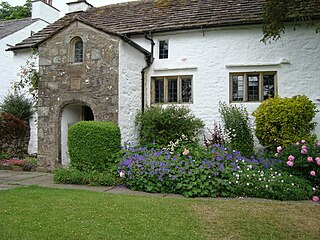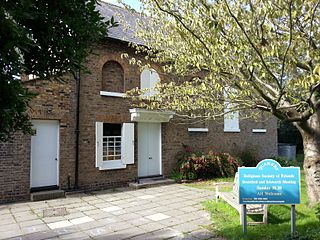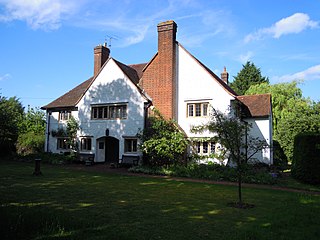Thomas Ellwood was an English religious writer. He is remembered for his relationship with poet John Milton, and some of his writing has proved durable as well.

Amersham Rural District was a rural district in the administrative county of Buckinghamshire, England from 1894 to 1974, covering an area in the south-east of the county.
Isaac Penington (1616–1679) was one of the early members of the Religious Society of Friends (Quakers) in England. He wrote about the Quaker movement and was an influential promoter and defender of it.

Isaac Penington was an English politician who sat in the House of Commons from 1640 to 1653. He was Lord Mayor of London in 1642 and a prominent member of Oliver Cromwell's government.

Quakers are people who belong to a historically Protestant Christian set of denominations known formally as the Religious Society of Friends. Members of these movements are generally united by a belief in each human's ability to experience the light within or see "that of God in every one". Some profess a priesthood of all believers inspired by the First Epistle of Peter. They include those with evangelical, holiness, liberal, and traditional Quaker understandings of Christianity. There are also Nontheist Quakers, whose spiritual practice does not rely on the existence of God. To differing extents, the Friends avoid creeds and hierarchical structures. In 2017, there were an estimated 377,557 adult Quakers, 49% of them in Africa.

Brigflatts Meeting House or Briggflatts Meeting House is a Friends Meeting House of the Religious Society of Friends (Quakers), near Sedbergh, Cumbria, in north-western England. Built in 1675, it is the second oldest Friends Meeting House in England. It has been listed Grade I on the National Heritage List for England since March 1954. It is the subject of a twelve-line poem titled "At Briggflatts meetinghouse" by British modernist poet Basil Bunting. Bunting's poem was written in 1975 for the 300th anniversary of the meeting house's construction.
In the 17th century, the Quaker movement adopted the use of the word epistle following the example of its use in the New Testament. A Quaker epistle is an advisory or admonitory letter sent to a group of people; such a letter is sometimes termed a "general epistle". Epistles continue to be sent by Yearly Meetings in session to all other Yearly Meetings.

The Ifield Friends Meeting House is a Friends meeting house in the Ifield neighbourhood of Crawley, a town and borough in West Sussex, England. Built in 1676 and used continuously since then by the Quaker community for worship, it is one of the oldest purpose-built Friends meeting houses in the world. It is classified by English Heritage as a Grade I listed building, a status given to buildings of "exceptional interest" and national importance. An adjoining 15th-century cottage is listed separately at Grade II*, and a mounting block in front of the buildings also has a separate listing at Grade II. Together, these structures represent three of the 100 listed buildings and structures in Crawley.

The Brighton Friends Meeting House is a Friends meeting house in the centre of Brighton, part of the city of Brighton and Hove in East Sussex, England. The building, which dates from 1805, replaced an earlier meeting house of 1690 what was then a small fishing village on the Sussex coast. Located at the junction of Ship Street and Prince Albert Street in The Lanes, the heart of Brighton's "old town" area, its architectural and historic importance has been recognised by English Heritage's granting of Grade II listed status.

Littlehampton Friends Meeting House is a Religious Society of Friends (Quaker) place of worship in the town of Littlehampton, part of the Arun district of West Sussex, England. A Quaker community has worshipped in the seaside town since the 1960s, when they acquired a former Penny School building constructed in the early 19th century. The L-shaped, flint-faced structure, consisting of schoolrooms and a schoolmaster's house, has been converted into a place of worship at which weekly meetings take place. The house is a Grade II Listed building.

The Adelaide meeting house of the Religious Society of Friends ("Quakers") is situated on Pennington Terrace, North Adelaide, South Australia, literally in the shadow of St Peter's Cathedral, on its west side. It is substantially made of timber, the only such church building in the City. Besides Sunday meetings, weddings and the like, it has also hosted secular meetings, particularly for peace, education, temperance and other social causes. It also served briefly for Adelaide's Presbyterian congregation prior to construction of the Church of Scotland building on Grenfell Street, also for the North Adelaide congregation of the Church of England.
Longford Meeting House is a Grade II listed building, formerly used by the Society of Friends for worship, that stands on a site at the south side of Bath Road, Longford, a short distance to the east of the Duke of Northumberland's River.

Godalming Friends Meeting House is a Friends meeting house in the ancient town of Godalming in the English county of Surrey. One of many Nonconformist places of worship in the town, it dates from 1748 but houses a congregation whose roots go back nearly a century earlier. Decline set in during the 19th century and the meeting house passed out of Quaker use for nearly 60 years, but in 1926 the cause was reactivated and since then an unbroken history of Quaker worship has been maintained. Many improvements were carried out in the 20th century to the simple brick-built meeting house, which is Grade II-listed in view of its architectural and historical importance.

The Brentford & Isleworth Meeting House is a Friends meeting house on Quaker Lane in Isleworth, Hounslow. It is listed Grade II* on the National Heritage List for England. The meeting for worship is held on Sundays at 10:30 am.

The Finchley Meeting House is a Friends meeting house at 58 Alexandra Grove in Finchley, London N12.

The Hampstead Meeting House is a Friends meeting house at 120 Heath Street in Hampstead, London N3. It was designed by Fred Rowntree in the Arts and Crafts style. The friends had previously met in Willoughby Road from 1903. The Hungarian emigrant sculptor Peter Laszlo Peri was an elder of the Hampstead meeting; having joined in 1945.

The Westminster Meeting House is a Friends meeting house at 52 St Martin's Lane in Covent Garden, London WC1. It shares its frontage with an adjoining shop. The Westminster friends have been meeting at this location since 1883.
The Grange was a country house and estate at the village of Chalfont St Peter in Buckinghamshire, England, in the United Kingdom.

Howgills in Letchworth Garden City, Hertfordshire, England, is a Grade II listed building on the Register of Historic England in use as a Meeting House for the Society of Friends (Quakers).















